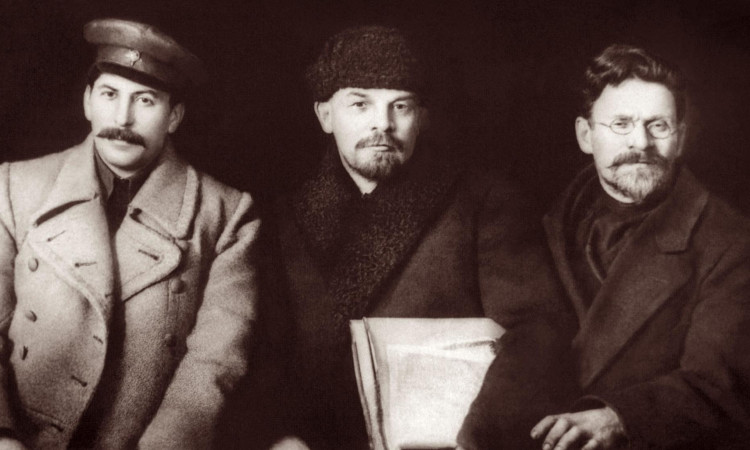Until the USSR furnished living proof, the capitalists had always insisted that the demands of workers that such essentials as housing, employment, healthcare, education, pensions etc should be guaranteed to them were simply too expensive to be met; that enterprises would be rendered uncompetitive and workers would end up losing their jobs altogether if employers had to fork out for anything over the basic wage bill.
But the universal provision of all the necessities of life in the USSR, and the constantly-rising quality of life that was achieved by Soviet workers and peasants during the 1930s – without exploiting its own workers or superexploiting any others, and, moreover, at a time when the rest of the world was in the clutches of a catastrophic economic crisis – inspired workers and oppressed people everywhere with a vision of what socialism could offer them. The experience of the great depression, of imperialism’s fascist brutality in crisis, and of the horrendous war that the crisis spawned brought workers all over the world towards revolution.
The incredible achievements and heroic sacrifices of the Soviet people in defeating Nazi Germany added to the already high prestige of communism. The name of Josef Stalin, the Soviet people’s great teacher and leader, was revered by workers and peasants throughout the world. Revolutions swept across the formerly occupied territories of Europe and throughout the colonies and semi-colonies. From China and Korea in the east to the European people’s democracies in the west, socialism spread like a mighty wave.
In the centres of imperialism, the capitalists suddenly found that it was not only possible, but entirely practical and necessary to provide certain basic minimums to workers at home: the age of ‘welfare capitalism’ was born.
It is a little understood fact that we in Britain owe our NHS, our council houses, our school and university system, our pensions and our unemployment benefits directly to the October Revolution – to the example it set, to the inspiration and courage it gave to the workers of the world, and to the terrible fear it put into the hearts of the capitalists, who saw the foundations of their rule crumbling away before their eyes.
The welfare state – a temporary pacifier
The provisions made for workers by the British welfare state improved life for almost everyone in the country. Still, it is instructive to compare these gains with what was provided to workers in the Soviet Union so we can see just what a difference is made when the whole of the state is geared up for meeting the needs of the people, as opposed to just a few parts of it – parts which, moreover, cannot but come into conflict with the general priorities of a capitalist society.
As we are seeing very clearly today, the welfare provisions that were conceded by a hard-pressed ruling class whose system was in dire trouble have proved to be a temporary stabilisation measure. Once the post-war reconstruction boom was over, capitalism lurched back into economic crisis, and the gradual chipping away at the welfare state began.
With the collapse of the Soviet Union, that gradual chipping was replaced by a wrecking ball. And the inexorable intensification of the crisis is now bringing wholesale destruction to the very foundations of health, housing, education and benefit systems that British workers once believed they had won for good.
Even before the gradual erosion of these rights and concessions, however, there were definite limitations as to what could be achieved for workers under even the most favourable capitalist conditions.
Public services shaped by the needs of capital
Universal healthcare provision in Britain was a great step forward compared to that which workers were able to access before the war, most of which was prohibitively expensive and almost all of which was dependent on income or charity. In the context of the NHS’s foundation, it is not particularly surprising to note that it came with two very big downsides.
First, social welfare of all kinds was paid for not only through taxes on British workers’ salaries, but also through increased exploitation of Britain’s colonies – through the blood and sweat of oppressed and superexploited workers all over the world. Second, social provision here has always been shaped by the needs of capital as well as by those of workers, with the former increasingly gaining the upper hand as the balance of class forces has shifted in favour of the bourgeoisie.
Established in 1948, Britain’s new health service was financed from central government taxation. Care was meant to be entirely free at the point of use, although prescription, dental and optical charges were introduced in the early 1950s, to help pay for British imperialism’s participation in the war of aggression against the Korean people. Everyone was eligible for care, even people temporarily resident or visiting the country, and anyone could be referred to any hospital – local or more distant. (See Short history by Geoffrey Rivett, nhshistory.net)
According to a 2006 Proletarian article, however: “From its inception, the NHS preserved elements of private medicine. While hospitals were nationalised (through massive negotiated payment rather than seizure), GPs, dentists, opticians and community pharmacists remained small businesses, independent practitioners contracting to provide the NHS with a certain amount of service. And while hospital consultants became salaried employees, they too were contractually free to pursue private medicine in parallel. Thus the wealthy have always been able to obtain the ‘special treatment’ they desire and the pathway back to predominantly private medicine has lain dormant within the NHS, just waiting for conditions favourable to its re-establishment.” (End in sight for National Health Service, August 2006)
Much is made of the ‘equality of service’ that was provided to British workers in the heyday of the NHS, but, while things were certainly more equal, it is by no means possible to talk about real equality in a situation where members of the monopoly capitalist ruling class and their highest-paid servants not only had access to private medicine, but also enjoyed vastly better conditions of life than the rest of the population.
As pointed out in the Proletarian article cited above: “there can be no real talk of ‘equality’ between the multibillionaires, the emperors of finance capital, on the one hand and the working masses on the other … Health care is, of course, an emotive issue, one that highlights the severe consequences of poverty, inequality and exploitation of capitalism in the ultimate black and white terms: life or death.”
Study after study has shown the intrinsic relationship between housing and education quality, nursery provision, wage levels etc and health outcomes, but only in socialist countries are these inequalities addressed in any meaningful way.
When Cuba announces a further rise in the life expectancy of its people (presently standing at 79 years), this achievement is all the greater because it does not hide within it a gaping disparity between haves and have-nots. The average life expectancy in Britain today is 81.5 years, but the idea that this means ‘everyone is living longer’ is a fallacy. In the poorest parts of Britain, life expectancy for men can be more than 25 years lower than that, and there is every reason to suppose the disparity will continue to grow as austerity and unemployment bite deeper and the poor in Britain get steadily poorer. (See Conditions for the working class in 21st century Britain: Health)
The NHS in capitalist Britain has never been able to raise the wages, dietary standards, housing conditions or cultural life of its patients, nor is it in any position to tackle the insecurity and stress that are a standard part of life as a worker in any capitalist country. NHS GPs can only dream of having the resources and time to carry out annual examinations on all their patients, of making regular home visits and of really knowing the communities they serve.
And what medical practitioner wouldn’t feel happier knowing that safety measures in industry had been brought under the remit of the department of health, or that when dietary changes were needed to improve a patient’s health, their implementation could be subsidised and overseen? Numbers of doctors and hospital beds per head of the population in Britain have never been at the level that is considered necessary in a socialist society. In Cuba today, there are 59 doctors for every 10,000 people; in Britain, there are 27.
At its best, then, Britain’s NHS was incomplete in scope and flawed in implementation. Today, as the economic crisis bites ever deeper and the capitalists are driven to desperation in their quest for avenues of profitable investment, we are witnessing the final stages of its effective abolition.
The Soviet health system
Socialist Cuba’s achievements in the fields of health and education are today relatively widely known, but it is less well understood that the pioneers of every kind of service provision to working people were the Soviets. It was they who first implemented an approach to healthcare that was not just about treatment of symptoms and diseases, but primarily about disease prevention.
Tying this in to the need to look after the wellbeing of every person in society, the Soviet government focussed on creating security and stability through the provision of decent housing, education, employment and cultured leisure time to every citizen. It strove to help workers feel useful and happy, to reduce stress and provide all that is needed for a fulfilling life.
According to Prof N Propper-Grashchenkov, assistant people’s commissar of public health during this period: “In the USSR … unemployment, destitution and poverty have been permanently done away with on the basis of the abolition of the exploitation of man by man. In a remarkably short period of time the socialist state has succeeded in raising the material and cultural level of the entire population enormously, thereby laying a firm foundation for successful work in the field of public health.” (Public health protection, USSR Speaks For Itself, 1941, our emphasis)
Capital, by contrast, stands powerless to address problems that the USSR solved with astounding speed. Many workers today in even the richest capitalist countries endure conditions that undermine their health from start to finish: overcrowded, insecure accommodation, poverty, isolation, poor food and polluted air are the basic building blocks of their lives. Even the most privileged of workers often find that they lack the time or opportunity to exercise, socialise or engage in leisure or cultural pursuits, living and working instead in a state of chronic long-term stress and sleep deprivation. Moreover, the fundamental sense of purpose and belonging that are provided by useful work and a sense of community are missing from their lives.
The USSR wiped out slums, built water mains and sewerage systems in town and country alike and electrified the country. The quantity and quality of food available to ordinary people was constantly increased. Moreover, the Soviet state included in its health work such key factors as environmental measures (protection of soil, water and air from pollution) and the organisation of public catering on a scientific and hygienic basis. Great emphasis was put on keeping doctors updated with the latest findings of medical research science.
Before the revolution, tsarist Russia had fewer than 20,000 doctors; by 1937, the Soviet Union had 132,000. The health budget in general was 75 times larger in 1937 than it was in 1913, and hospital beds increased from 138,000 in 1913 to 572,000 in 1939. By 1956, despite all the ravages of the war, there were 1.3 million hospital beds in the USSR – 67 per 10,000 people. In Britain today, there are just 28 per 10,000, and that number is steadily declining. (Central Statistical Board of the USSR, 40 Years of Soviet Power in Facts and Figures, 1958)
The quality of the hospitals also underwent a dramatic change. Soviet hospitals were clean, bright and pleasant places, staffed by well-trained specialists, equipped to the highest standards, connected to research institutes and providing not just medical but also carefully worked out nutritional care to their patients. As regards the education of new healthcare workers, within 20 years of the revolution, 14 new medical colleges and 133 medical secondary schools had been established.
Owing to the particular susceptibility of babies and toddlers to contagious diseases in those days, nursery places for children under the age of three and a half came under the control of the commissariat of public health. They increased in the same period from 11,000 to 5.75 million, offering working women a safe place to leave their children. In the whole of tsarist Russia, there had been just nine child and maternity welfare centres; in the USSR in 1938 there were 4,384. (See Prof Propper, op cit)
Services were first extended to reach all the people, and this was followed by a drive to improve quality – through better education of medical practitioners, by establishing new medical and scientific research institutes, and by nationwide drives to raise standards and understanding not only amongst medical professionals but in society as a whole.
There was a requirement on every single doctor to spend one day a month giving public lectures in preventive medicine – in public parks, lecture rooms, health centres and schools – which were backed up by poster campaigns, pamphlets and so on.
Thousands upon thousands of workers’ committees in factories, farms and workplaces cooperated with local health workers to give feedback and improve services; to oversee spending; to ensure hygienic conditions in their workplaces and nurseries; and to organise health education at work. They sent delegates to the local committees that supervised and inspected hospitals and sanitary establishments, and from there to the district supervising bodies and then to the commissariat of health.
Tsarist Russia had been a hotbed of contagious epidemic diseases, and these conditions became even worse during the first world war. The Soviet Union set to work after the revolution to turn this situation around, first eradicating plague, cholera and smallpox, and then making drastic reductions in the spread of typhus, typhoid fever, scarlet fever, measles, diphtheria and other mass killers.
There was not a single major disease epidemic during the second world war, despite the privations suffered all over the Soviet Union – a vivid testament to the work done before the war to ensure a firm foundation for public health.
Within 20 years of the revolution, the USSR had achieved:
– a 50 percent reduction in child mortality;
– an increase in height of nearly two inches on the average Soviet child as compared with 20 years earlier;
– a reduction in TB of 83 percent;
– a decrease in syphilis of 90 percent;
– a lowering in the death rate of 40 percent;
– a dramatic rise in the birth rate;
– a consistent decrease in the reported cases of sickness and accidents. (See Prof Propper, op cit)
This trend continued after the war too, as the Soviet people’s reconstruction drive enabled them very quickly to overtake pre-war levels of production. For instance, between 1934 and 1958 annual cases of malaria fell from 9.5 million to just 2,500.
The foundation for these achievements was laid in the rising conditions of life of the workers. In the three years from January 1934-37, for example, the prices of bread and butter fell by more than a half, eggs and sugar dropped by nearly three-quarters and meat was down by a third. During the same period, prices in Germany were rising and wages were falling. (See Hewlett Johnson, The Socialist Sixth of the World, 1939)
Wages for Soviet workers on the other hand, were rising dramatically, so that an average factory worker was earning in 1938 more than double what he had earned just five years earlier, even as prices of essentials were falling. All this could not but have a profound effect on the health of the nation. Professor Propper noted that by 1939 the Soviet people were consuming on average more than 100 grams of protein per day, as compared with 35-40 grams in Germany. (See Prof Propper, op cit)
Public dining rooms and restaurants offered a special catering service for those who had been put on particular diets to control conditions like diabetes or heart disease. Nutrition was an area of intense study within the Soviet health system and the principles and rules for public catering were carefully worked out. Dietetic stores also helped workers stick to these special diets by providing them with the right products for consumption at home. (Henry E Sigerist, Socialised Medicine in the Soviet Union, 1937)
Thus it can be seen that the Soviet Union not only understood that the ample provision of basic necessities is the cornerstone of a decent life, but was able to take action to see that such provision was made for all.
Industrial workers were closely monitored. Those working with dangerous substances worked shorter hours, had extra monitoring and were given extra foods. The health commissariat worked with industry to prevent the output of harmful substances into the air (such as filtering and capture systems in factories).
The health commissariat also put great emphasis on reducing industrial accidents, since “this work is directed towards safeguarding the life and health of the working man himself, the most valuable asset in the Soviet Union.” Safety procedures were everywhere introduced and first aid stations and clinics established in workplaces. These health stations were tasked not only with treating casualties, but also with monitoring working conditions and introducing measures for decreasing accidents and illness at work. (Prof Propper, op cit)
In Britain, by contrast, disparate campaigns had forced legislation in some areas of work, but by no means all. The first comprehensive health and safety law was enacted in 1974. The Health and Safety Executive, tasked with enforcing health and safety legislation in Britain, has been under attack for decades and is now a shadow of its former self. As a result, death and injury in the workplace are rising once again, and workers who speak out against dangerous conditions risk being fired. (See Health and safety timeline, HSE)
The staff in the USSR’s workplace health stations also monitored the general health of the workforce and selected people who they felt were in need of a visit to a rest home or sanatorium. By 1939, over two million workers a year were spending their vacations in beautiful resorts, at rest homes provided by the Soviet health service. (See Prof Propper, op cit)
The Soviet Union’s care for the environment was also second to none at that time. Much lower thresholds of dangerous gases were allowed into the Soviet Union’s air (eg, a 40 times lower limit of hydrogen cyanide was accepted in the air of the USSR than in the USA) – taking into account the chronic effect of small doses of noxious substances.
New methods of drilling and other anti-dust measures, including extensive ventilation, were brought into mines, accompanied by compulsory medical check-ups for all drilling miners in order to reduce and eradicate previously common lung diseases. Meanwhile, noise pollution controls were introduced in Soviet cities, ranging from muffling industrial procedures to banning the use of car horns in built-up areas.
As Hewlett Johnson (the ‘Red Dean’ of Canterbury) pointed out: “Science, in the Soviet Union, has an eye to health and beauty as well as material production. It aids the artist and the doctor. Science … gasifies coal in the seam and, with a minimum of human aid, delivers light, heat, and power direct to the users, preventing the consumption of raw coal in open fires, with fouling of air, rotting of buildings, and interception of ultra-violet rays. Raw coal fires are responsible for rickets and consumption and many other diseases. They draw a trail of ugliness across industrial areas … Clean skies and homes lie ahead for Soviet workers.” (Hewlett Johnson, The Socialist Sixth of the World, 1939)
This was at a time, it must be remembered, when dirt and pollution were thought to be an inescapable consequence of industrial activity. In Britain, the Clean Air Act that finally put an end to London’s notorious smog did not come into effect until 1956. Legislation to protect miners from lung disease was not passed in Britain until 1975, and even then it was essentially unenforceable. (See Britain at work: Health and safety by Dave Lyddon, unionhistory.info, 2012)
In the USSR, by contrast, the application of modern technology in the service of the people led to world-leading new techniques in all areas of life. Hewlett Johnson gave one example of this from the world of medicine, recounting how the new Soviet-pioneered technique of blood storage was enabling lives to be saved and medical science to advance.
“The president of the International Congress on Blood Transfusions emphasised the fact that the Soviet Union occupies a leading position in the science of blood transfusion. It was Soviet scientists who first discovered how to keep blood for future use. Before that discovery blood transfusion was only practised by direct contact of giver and receiver. The Soviets sent the knowledge of their method to help the Spanish republicans in their struggle against aggression.”
By 1937, the USSR had 830 district blood transfusion stations, and there was no lack of volunteers willing to donate. The story of one donor is told in Johnson’s book: “Tanya Barova was once saved by blood transfusion. Now she offers her own blood as a thank-offering. She is examined by seven doctors to see if her blood is healthy and she herself strong enough to sacrifice good blood.
“Her blood is declared fit and a third or a half pint taken. Special nourishment restores her, and she comes again in six weeks time to repeat her offering.” (Hewlett Johnson, op cit, our emphasis)
Planning: the key to socialism’s success
At its heart, socialist medicine is about the needs of the people, and the ability to meet those needs rests on socialist society’s ability to plan. Socialist planning gains its great strength in that it is applied not merely to each separate area of life, but to all of them together, in an integrated, holistic way that takes into account the interconnectedness of all aspects of life – that appreciates, for example, the connection between housing, employment, nutrition and health.
In its heyday, Britain’s NHS owed its great efficiency to “a similarly integrated structure under the management of centralised health authorities, whose function included planning resource distribution and service provision in accordance with scientific statistical knowledge of actual and projected clinical need on a large regional basis”. (End in sight for National Health Service, Proletarian, August 2006)
This ability to plan was a great strength of the NHS, but the inability to create a wider plan for society covering all aspects of life – or even to control all aspects of healthcare within the NHS’s remit – weakened it from the start. Still, it was noticeable that one of the most important steps in dismantling the NHS has been to destroy the organisation’s ability to plan nationally, dividing it up and devolving responsibility for local planning onto smaller and increasingly isolated units that are today being more and more transformed into stand-alone businesses.
We will deal in more detail with the strengths and mechanisms of a planned economy in another issue, but even from the brief insights afforded us in this article, it is clear that the Soviet health system was very much better than anything the best, most enlightened, most well-funded capitalist health service could ever deliver.
In the light of all the available evidence, there can be only one conclusion: capitalism kills! If we want a decent and secure healthcare system, we must demand not merely the restoration of the NHS, but the abolition of the capitalist system. The road to its abolition is the road of the October Revolution.














